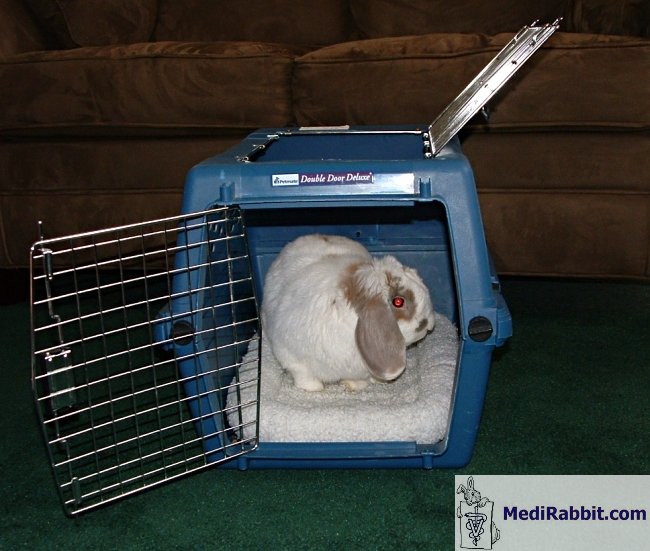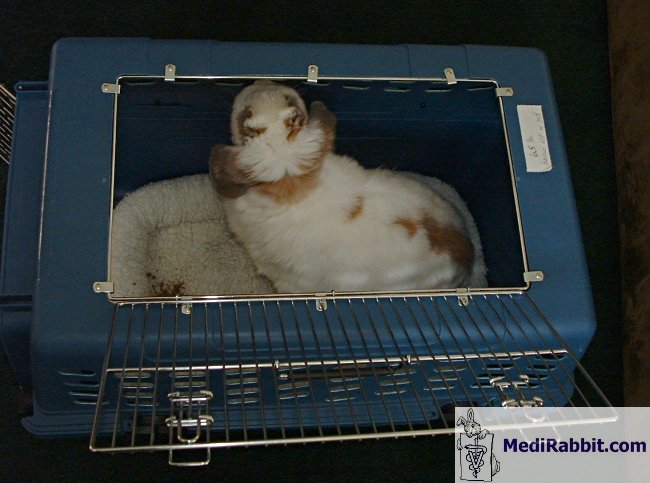Best type of carrier for rabbit transport
Esther van
Praag, Ph.D.
MediRabbit.com is
funded solely by the generosity of donors.
Every
donation, no matter what the size, is appreciated and will aid in the continuing
research of medical care and health of rabbits.
Thank you
|
|
Rabbits are easily stressed and their transport
represents a challenge. Allergens, sunlight, car lights, noise, hot or cold
temperatures, and being subjected to visual observation by people or other
animals could potentially stress a rabbit in a carrier. The carrier used for
transporting should, thus, be sturdy so as to protect the animal from
exposure to the environment as much as possible and prevent escape. The carrier should, furthermore, have a
solid bottom, with no grid or holes that can cause injury. Nylon or cloth
pet carriers, as well as cardboard boxes, must be avoided since a rabbit can
easily make holes in these materials. A rabbit that has escaped from the
carrier in a car can lead to extremely dangerous situations. The rabbit can
startle the driver by jumping onto his or her lap, thereby distracting the
driver's attention and concentration away from the road, or the driver may
need to locate the rabbit in the vehicle, all potential causes of accidents.
A free roaming rabbit in a car can, moreover, be propelled through the
windshield during a sudden unexpected stop.
Adar, a Flemish giant rabbit
travelling by train Never
take chances !!! A rabbit should travel in a sturdy carrier that
ensures a safe environment. The waiting
room at the veterinary clinic is a further source of stress for the rabbit.
When removed from the safe environment of its carrier, it may panic, bite,
and scratch in an attempt to escape The carrier of
choice has a front opening and a top opening:
Duncan
The top
opening is convenient for checking on the rabbit, petting, feeding, or giving
fresh drinking water during a stop. The rabbit cannot get out and escape as
easily as through the front. If the rabbit reaches up to the top opening, it
can be gently pushed down in the carrier. A top opening
is, furthermore, useful during a visit to the veterinarian. Rabbits tend to
crawl into the back of their carrier when the surroundings are not familiar
or when they hear strange noises or smell unusual odors. When approached from
the front, they respond with aggression, biting and scratching the hands of
the owner or veterinarian, thereby making it difficult to be removed from the
carrier. When a rabbit sees hands approaching through the top opening, it has
a tendency to crouch downward. Usually the rabbit can be picked up through
the top opening without much trouble, with a firm hold to prevent escape, and
support of the lower spine region and hips to prevent fracture. Care must, nevertheless,
be taken that the rabbit does not charge out or escape through the top
opening. Usually, the rabbit can be picked
up through the top opening without much trouble, with a firm hold to avoid escape, and support of
the lower spine region and hip of the rabbit to avoid fracture.
For safe carrying methods of a rabbit, see: Safe carrying of a
rabbit
Padding of the
transport carrier Ventilation of
the transport carrier Size of a
carrier Aside
price and quality, the choice of carrier depends on the size and number of
rabbits that will travel in it. It should not be oversized nor overcrowded.
The carrier should provide comfort and allow lying down and stretching out.
Different carriers used to transport one
to two rabbits: ·
The smallest (left, 27*43 cm / 10.6*17.2, 30 cm /
12 high) can transport two dwarf rabbits or one small sized rabbit. ·
A mid-sized carrier (30*46 cm / 11.8*18.1, 36 cm /
14.1 high) can be used for one giant breed or two medium sized rabbits. ·
The folding carrier (right, 46*54 cm / 18.1*21.3,
35 cm / 13.8 high) was used to transport a giant Flemish giant and a medium
sized rabbit. |
_____________________________________________________________
A big
special thanks to Duncan for his help and demonstration of his transport
carrier.
Thank also to little Stampi and giant Adar.
Thanks to B. Salt and T. Saarony for their contribution.
e-mail: info@medirabbit.com
















